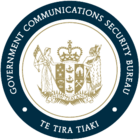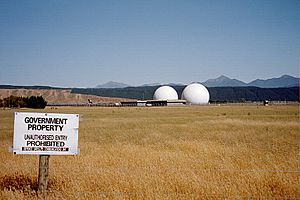Government Communications Security Bureau facts for kids
 |
|
| Agency overview | |
|---|---|
| Jurisdiction | New Zealand |
| Headquarters | Pipitea House, 1-15 Pipitea St, Pipitea WELLINGTON 6011 |
| Minister responsible |
|
| Agency executive |
|
The Government Communications Security Bureau (GCSB) (Māori: Te Tira Tiaki) is a special government agency in New Zealand. Its main job is to help keep New Zealand safe. It does this by collecting and studying important information.
The GCSB works to protect New Zealand's security. It also helps other government groups. Its main tasks include:
- Keeping computer systems and information safe from online threats.
- Gathering information about what is happening in other countries.
- Helping other New Zealand government agencies with security matters.
Contents
How the GCSB Started
The Government Communications Security Bureau was created in 1977. This happened because Robert Muldoon, who was the Prime Minister of New Zealand at the time, asked for it.
Before 1977, different groups handled these jobs:
- Keeping communications safe was done by the Communications Security Committee. This group worked with the Prime Minister's office.
- Gathering secret information from signals (like radio waves) was done by the Combined Signals Organisation. The military ran this group.
- Stopping hidden listening devices (bugs) was the job of the Security Intelligence Service.
When the GCSB was set up, it took over all these important roles. At first, the GCSB was part of the Ministry of Defence. Its work was very secret. Even the New Zealand Cabinet (a group of top government ministers) was not fully told about it.
In the 1980s, more information about the GCSB slowly became public. People learned about its role in security. They also learned about its work gathering information from signals.
Also in the 1980s, the GCSB became a separate organization. It was no longer part of the Ministry of Defence. In 2000, it was decided that the GCSB should become its own government department. This change officially happened with the Government Communications Security Bureau Act 2003.
In 2001, a group called the Centre for Critical Infrastructure Protection was formed within the GCSB. This group helped protect important national systems, like power grids, from computer attacks. In 2011, the National Cyber Security Centre was created within the GCSB. It took over the jobs of the earlier Centre.
Who Works at the GCSB and Its Budget
The GCSB is a government department. Its main office is in Wellington, New Zealand. The person in charge of the GCSB is called the Director. The Director reports to a government minister. This minister is usually the Prime Minister of New Zealand.
The GCSB has about 300 staff members. These staff have many different skills. They include people who speak foreign languages. There are also experts in communications and codes. Engineers, technicians, and support staff also work there.
In the 2015/2016 financial year, the GCSB's budget was $89.6 million.
How the GCSB is Checked
An Inspector General watches over the GCSB. This person also checks other intelligence groups. In 2013, a former judge named Paul Neazor held this role. He had one staff member to help him.
The Prime Minister chooses both the Director of the GCSB and the Inspector General. Some people, like law experts, think that Parliament should choose the Inspector General instead. This would make sure the Inspector General is more independent.
What the GCSB Does
The GCSB performs several important functions. These include:
- Signals intelligence: Gathering information from electronic signals.
- Communications security: Protecting New Zealand's own secret communications.
- Anti-bugging measures: Finding and removing hidden listening devices.
- Computer security: Protecting government computer systems from attacks.
The GCSB does not usually say what kind of communications it listens to. Some authors, like Nicky Hager, say it is part of a global network called ECHELON. In 2006, a report from 1985–86 was found. It listed countries that the GCSB had focused on. These included Japan, the Philippines, Argentina, France, Vietnam, and many small Pacific island states. It also mentioned diplomatic messages from the United Nations.
During the Cold War, the GCSB focused on tracking Soviet ships. This included civilian ships like fishing boats.
The GCSB uses two main "listening stations" for its signals intelligence work:
- The Waihopai Station is near Blenheim. It intercepts satellite communications.
- The Tangimoana Station is near Palmerston North. It intercepts radio communications.
In 2015, it was revealed that the GCSB had a secret listening post. This post was called "Caprica." It was located at the New Zealand High Commission in Honiara, the capital of the Solomon Islands.
Waihopai Station Details
The Waihopai Station started operating in 1989. It is described as a facility that monitors satellite communications. It is located in the Waihopai Valley. Many people believe it is part of the ECHELON network.
Not many details about the Waihopai facility are public. However, it is thought to intercept and process phone calls, faxes, emails, and computer data. The site is often a place for protests. Activists want the base to be closed down. The Anti-Bases Campaign holds yearly protests there.
Tangimoana Station Details
The Tangimoana Station opened in 1982. It replaced an older facility near Waiouru. This facility is also believed to be part of the ECHELON network. Its role was first publicly identified in 1984.
Images for kids



